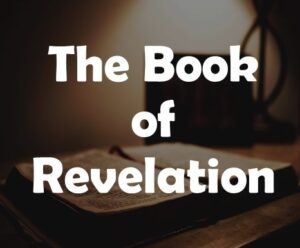Introduction
The seven last plagues finish with the end of the world. But God is not finished with what He wants us to know. He wants us to know why, how and who. He wants us to know why the world must come to an end. He wants us to know how the world comes to an end. He wants us to know who is responsible for the world coming to an end. The culprit is an entity called Babylon the great. Also known as ‘the great city’ and there is a scarlet robed woman reigning there, and she ‘sits’ on everything and she ‘sits’ on everything, everywhere. And because she is responsible for the destruction of the world, God wants us to be ‘witnesses’ to her judgement and wants us to warn her adherents that she is going to reap what she has sown.
The Two Women
The Book of Revelation is made up of contrasting opposites. This is because the enemy counterfeits everything that God is and everything that God does. Or at least he tries to – to the best of his ability. When one considers these counterfeiting phenomena, it becomes obvious why it is essential and necessary for the enemy to operate in this manner.
In his psalm of repentance David tells us that God “delights in truth” (Ps. 51:6). Jesus has told us that He is, “the way, and the truth, and the life (Jn. 14:6). And if humanity would pursue the truth, He also told us that, “the truth shall set you free” (Jn. 8:32). By contrast we are told that the enemy, is the opposite to God in character and deed:
He was a murderer from the beginning, and abode not in the truth, because there is no truth in him. When he speaketh a lie, he speaketh of his own: for he is a liar, and the father of it. Jn. 8:44.
When we swear an oath in court to tell the truth, we recite the well-known formula, “I swear to tell the truth, the whole truth and nothing but the truth, so help me God.” We say this because it is recognised that there is deception and lies in the world, but the standard for truth is God. And this is because God’s Kingdom is based on truth because, “This then is the message which we have heard of him, and declare unto you, that God is light, and in him is no darkness at all” (1 Jn. 1:5). Whereas the counterfeit kingdom of Satan is based on deception, lies and darkness (see Matt. 4:6; 6:23; Lu. 22:53; Jn. 3:19; Eph. 6:12; Col. 1:13 etc.).
Because the purpose of Satan’s kingdom, is to counterfeit everything in and of the Kingdom of God, this means that he has duplicates (in counterfeit form) of everything pertaining to God and His Kingdom. Thus, for every truthful thing, there is a false counterfeit. For every truthful doctrine, there is a false doctrine. If there is a truthful plan of salvation, there will be a false counterfeit plan of salvation. These lies of the enemy are not just false, they are counterfeiting fakes – which means they mimic the true as closely as possible – they cannot be convincing lies unless they resemble the truth as closely as possible.
Therefore, when it comes to the Revelation given to John, Jesus wants us to know that the last days will resemble a great battle between two women. One is the true, and the other the false. The true woman is standing on the moon clothed with the sun. The counterfeit false woman, is sitting on the waters of the world, and riding the beast, and clad in expensive worldly garments. We know who the woman standing on the moon is, but who is the woman sitting on the water, and riding the beast?
Who is the Woman Riding the Beast?
In certain circles it is commonly understood, that the woman sitting on the many waters and riding the beast is a repeat and enlargement of the sea beast – the Roman Catholic Church. And this is true, but it is only half of the truth. In chapter 13, we have already identified the sea beast as being the Roman Catholic Church. The Roman Church is depicted as a composite beast, with seven heads and ten horns. When we arrive at Revelation chapter 17, we have the same beast depicted, a composite beast with seven heads and ten horns – both of them repeatedly described as being full of the names of blasphemy – it is the same beast. The sea beast in chapter 13, is the same sea beast in chapter 17. The Roman Church is chapter 13, is the same Roman Church in chapter 17. However, in keeping with the principle of repeat and enlarge the sea beast in chapter 17, now has the addition of a woman riding it.
There is much to learn and understand from the addition of the woman. Firstly, she is in charge. A rider on any type of animal indicates that the animal is being steered by the rider. Therefore, the first thing we can learn and understand is that the sea beast/Catholic Church has a ‘rider’ controlling it and steering it.
The second thing we can understand, is that she is ‘revealed.’ The Greek word translated revelation is, ‘ἀποκάλυψις’ and it means ‘unveiling’ – ‘uncovering’ – ‘revealing.’ This depiction in chapter 17 is about the judgment of the sea beast/Catholic Church. In a judgment before a court, all the facts about the defendant are revealed, before a proper judgment and sentencing can take place. Therefore, in this judgment the sea beast/Catholic Church is finally exposed for what it is. The whole colossal evil edifice, is exposed for all the world to see and understand. This is why John wonders with great admiration because he sees it all, and it is an awesome sight. The same will occur to the people of the world in the last days, they too, will see it all, but they will be beside themselves with anger, and will rip the whole colossal evil edifice to pieces (see Rev. 17:16).
The third thing we can learn and understand about this woman, is that because this is a repeat and enlargement we can understand, that this woman has always been there riding the beast. But she has been concealed from sight – she is has not been prominently or publicly present – she is in the background – she ‘rides the beast’ from behind curtains away from the gaze of the general public. However, Jesus does not leave us uninformed and deceived. We know that this woman has always been steering the Catholic Church, because Jesus has already told us so. We know from previous study that the messages to the Seven Churches are about the history of the Church from the time of Jesus to the end of time. The fourth church covers the 1260-year period of Roman Catholic Church supremacy. Jesus tells us that there is a ‘woman’ in the Roman Catholic Church and steering it in the wrong direction:
And unto the angel of the church in Thyatira write; These things saith the Son of God, who hath his eyes like unto a flame of fire, and his feet are like fine brass; I know thy works, and charity, and service, and faith, and thy patience, and thy works; and the last to be more than the first. Notwithstanding I have a few things against thee, because thou sufferest that woman Jezebel, which calleth herself a prophetess, to teach and to seduce my servants to commit fornication, and to eat things sacrificed unto idols. And I gave her space to repent of her fornication; and she repented not. Behold, I will cast her into a bed, and them that commit adultery with her into great tribulation, except they repent of their deeds. And I will kill her children with death; and all the churches shall know that I am he which searcheth the reins and hearts: and I will give unto every one of you according to your works. Rev. 2:18-22.
Here we are told that the woman in the midst of the Roman Catholic Church is Jezebel. And what does she do in the midst of this church? – She infuses the place with paganism. She seduces the people into committing fornication. Fornication is illegal sexual union. In other words, she leads the people of God into illegal union with the world. This is the same accusation that Jesus makes against the same woman in chapter 17 – “With whom the kings of the earth have committed fornication” (Rev. 17:2). The woman in chapter 17 is a repeat and enlargement of the woman in chapter 2. And the Old Testament Jezebel is the type and the woman in chapter 2 and 17 are the antitype.
Jezebel
God told the Israelites, that they were to be holy and not to touch the unclean thing (see Lev. 11:44, 45; Isa. 52:11; 2 Cor. 6:17; 1 Pet. 1:16). They were to be in the world, but not to be a part of the world. They were to be the representatives of God, in a fallen world, therefore they were called to resemble God Himself in all things, to all people. A major part of being in the world, but not ‘touching’ the unclean thing, was not to ‘mingle’ themselves with the surrounding pagan nations. They were not to commit ‘fornication’ with them. They were not to marry pagans. In the eyes of heaven this was an illegal union comparable to fornication. Nevertheless, in spite of the law, the Bible pointedly records the consequences of Ahab, the king of Israel’s ‘fornication:’
And it came to pass, as if it had been a light thing for him to walk in the sins of Jeroboam the son of Nebat, that he took to wife Jezebel the daughter of Ethbaal king of the Zidonians, and went and served Baal, and worshipped him. 1 Kings 16:31.
The names of Jezebel and her father, indicate who they worshipped. Not only did they worship Baal, but Jezebel was a priestess of Baal – she was an evangelist for Baal. She seduced the king and the country, and she was so successful, that Elijah thought he was the only faithful Israelite left (see 1 Kings 19:10-18).
The story of Abab, Jezebel and Elijah, is a great Old Testament drama. The whole scenario is a type which points forward to antitypical fulfilments in the last days. The woman sitting on the waters and riding the beast is a last day manifestation of Jezebel. She committed fornication with a king of the earth, in the Old Testament, she commits fornication with the kings of the earth in Revelation. She led the people of God into paganism and apostasy in the Old Testament, she leads the people of God into paganism and apostasy in Revelation. She was torn to pieces by dogs in the Old Testament (see 1 Kings 21:23, 24), she will be torn to pieces by people in Revelation (see Rev. 17:16).
Paganism in the Church
The reason why Jezebel is portrayed as seducing the church in chapter 2 and sitting on the waters and riding the beast in chapter 17, is because she is being used as a symbol for paganism. Not only is she a symbol for paganism, she reflects reality. Not only is she a reflection of reality, she is indicating the utter and complete penetration of paganism in the Roman Catholic Church. In other words, everything about ‘that woman’ in Revelation is telling us that paganism rules the Roman Catholic Church – paganism is ‘riding’ the Roman Catholic Church.
Prior to Emperor Constantine, paganism was already penetrating the Christian Church. However, it was after the conversion of Constantine, and his subsequent establishment of the Roman Catholic Church, that paganism in the church quickly escalated. It escalated because the Roman Empire was pagan, and in order to ‘convert’ the pagans to Christianity the emperors and church leaders, thought that conversion would be facilitated by incorporating much, if not all, the trappings of paganism into the church. Thus, the pagans would feel more ‘comfortable’ and amendable if they were invited to join a church with familiar customs and rituals. This policy of ‘baptizing paganism’ into the church was very successful. It was so successful, that not even the Catholics themselves deny, that it happened. In fact, they applaud the success, such as this admission from Cardinal Newman:
Confiding then in the power of Christianity to resist the infection of evil, and to transmute the very instruments and appendages of demon-worship to an evangelical use… the rulers of the Church from early times were prepared, should the occasion arise, to adopt, or imitate, or sanction the existing rites and customs of the populace, as well as the philosophy of the educated class. We are told in various ways by Eusebius, that Constantine, in order to recommend the new religion to the heathen, transferred into it the outward ornaments to which they had been accustomed in their own. It is not necessary to go into a subject which the diligence of Protestant writers has made familiar to most of us. The use of temples, and these dedicated to particular saints, and ornamented on occasions with branches of trees; incense, lamps, and candles; votive offerings on recovery from illness; holy water; asylums; holydays and seasons, use of calendars, processions, blessings on the fields; sacerdotal vestments, the tonsure, the ring in marriage, turning to the East… are all of pagan origin, and sanctified by their adoption into the Church. Cardinal John Henry Newman, Essay on the Development of Christian Doctrine, 1878, p. 372-374.
Historians of all warp and woof, tell the same story. They add the nuances to the story, that this policy of amalgamation, was accomplished for the sake of political and religious unity. This was not an era when multiculturalism was encouraged. The Roman Empire was multicultural and multi-religious, but this was regarded as a weakness and a danger. The political and religious powers wanted a uniform united society, and amalgamation and conformity were the desired outcomes. Therefore, paganism and church needed to unite:
In the early part of the fourth century, the emperor Constantine issued a decree making Sunday a public festival throughout the Roman Empire. The day of the sun was reverenced by his pagan subjects, and was honoured by Christians; it was the emperor’s policy to unite the conflicting interests of heathenism and Christianity. He was urged to do this by the bishops of the church, who, inspired by ambition, and thirst for power, perceived that if the same day was observed by both Christians and the heathen, it would promote the nominal acceptance of Christianity by pagans, and thus advance the power and glory of the church. E. G. White, The Great Controversy, p.53
Even secular reference works, dealing with Roman and Church history tell the same story – that paganism and Christianity did not fight each other, until one defeated the other – they actually merged together:
It appears that the numbers of Christians had by this time [3rd century] grown sufficiently to alarm the government… [the emperors] seemed to recognize that Christianity would destroy the Roman Empire if it destroyed paganism. They did not foresee that Christianity would reach a compromise with the empire, that it would become Roman. Encyclopedia Britannica, art. Roman Catholic Church, vol.15, p. 987.
And the Bible tells the same story. There are five empires in the figure shown to Nebuchadnezzar and Daniel. But the fifth empire is different to the previous four. The first four are symbolized by one specific metal. However, the fifth is in a category of its own – it is an amalgamation of iron and clay. The iron is Rome and the clay is the Church. The mingling of iron and clay is the type and the woman riding the beast is the antitype.
There is another method, whereby one can see and understand that the Roman Catholic Church is infused with paganism. One only needs to view visually, the rituals, the monuments, the construction, the statues, the ornaments, the artwork, the decorations, the vesture, the architecture, etc. etc. – to recognise and know, that the origins of all these things are pagan. Including the following:
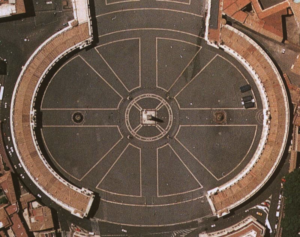
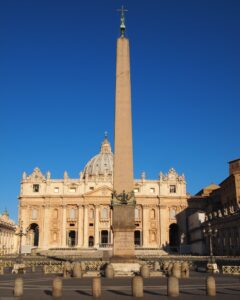
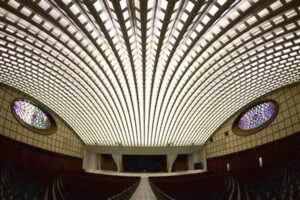
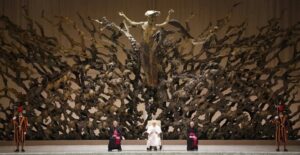
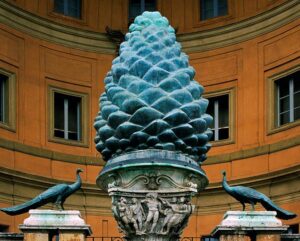

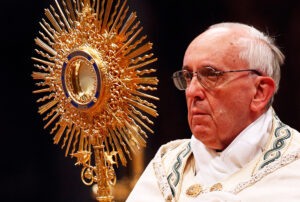
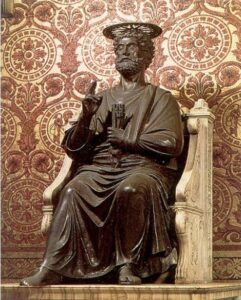
Conclusion
We are told in Revelation chapter 2, that the Roman Catholic Church has Jezebel, working assiduously to lead God’s people to corrupt themselves, with paganism. The people are deceived into complying, because they are taught that these pagan intrusions have been ‘sanctified’ by the church. Jezebel remains obscured in the church because only those with ‘spiritual discernment’ (see 1 Cor. chap. 2), can see her. However, she will be revealed in the last days, when judgment is pronounced against Babylon. The world will know and understand that she has been sitting on the waters and preparing to mount the beast ever since the apostle John warned us with these words; “…this is that spirit of antichrist, whereof ye have heard that it should come; and even now already is it in the world” (1 Jn. 4:3; cf. 2 Jn. 7).

